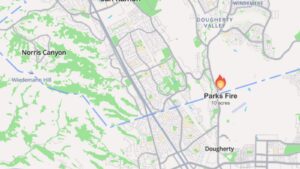A beautiful mountain town is feeling the effects of President Donald Trump’s rift with his counterparts in Canada.
Whitefish, Montana relies heavily on tourism from Canada to support local jobs, small businesses and maintain the spirit of the town.
‘Tourism touches nearly every part of life here,’ Zak Anderson, executive director of Explore Whitefish told the Missoulian of the town located just one mile from the US-Canadian border.
‘It’s what keeps our restaurants full, our lodges busy and our small businesses thriving.’
But since Trump ramped up his attacks on Canada by pushing for the country to join the US and implementing new duties on steel and aluminum, Canadian tourism is down in Whitefish by 25 percent.
‘Canadian travelers have always been some of our most consistent visitors,’ Anderson noted. ‘When they stay away, the impact is significant.’
He now blames the downturn in tourism on Trump’s tariff threats and shifting border policies, explaining: ‘It’s not that Canadians don’t want to come to Montana, it’s that they’re concerned about what to expect, and whether they’ll feel welcome.’
Some may have heard stories about tourists caught in the web of US immigration enforcement amid Trump’s rampant deportation efforts that forced the Canadian government to revise its advisory for citizens visiting the United States.
Whitefish, Montana is feeling the strain of President Donald Trump’s growing rift with his counterparts in Canada
Whitefish relies heavily on tourism from Canada to support local jobs, small businesses and maintain the spirit of the town
Tourism to the town from the northern neighbor is down 25 percent
It said travelers must ‘comply and be forthcoming in all interactions with border authorities’ and warned that visitors ‘could be detained while awaiting transportation.’
The United States has since shot back with its own guidance to Americans visiting the northern neighbor, warning about the country’s ongoing problems with wildfires.
But as Trump and Canadian Prime Minister Mark Carney continue to trade barbs, Anderson said Whitefish is suffering.
Businesses that make staffing and supply decisions months before the usually busy summer travel months are now fighting hard to survive, he said.
‘Many small businesses, like restaurants run on tight profit margins,’ Anderson explained. ‘So when prices on nearly everything increase, it makes it harder to stay profitable, regardless of what’s happening with visitation.’
An increase in domestic tourism during the peak summer months has not helped either, Anderson claimed.
‘Many of our US visitors are here for shorter stays, and Canadians are historically repeat business – especially in the off-season when our businesses need it the most,’ he said.
‘The uncertainty in the market is driving a “hyper seasonal” trend that is less sustainable.’
Zak Anderson, the executive director of Discover Whitefish, blames the downturn of Canadian tourists on President Donald Trump’s tariff threats and shifting border policies
At the same time, towns like Whitefish and nearby Kalispell are dealing with staffing reductions at Glacier National Park amidst near-record visitation.
The national park, which brings in 44 percent of Montana’s tourists, lost an estimated quarter of its staff due to Department of Government Efficiency cuts, buyouts and a hiring freeze earlier this year, NPR reports.
Visitors are now seeing reduced services inside the park, affecting everything from trail access to traffic management and even restroom maintenance.
That is putting more of a strain on Whitefish to meet the park-goers demands.
‘Communities in Montana are resilient, but when the rules keep changing, it becomes harder to plan, invest or build for the future,’ Anderson said.
In order to try to draw some Canadian tourism back, Glacier Country CEO Racene Friede spearheaded a campaign emphasizing the longstanding relationship between Montana and Canada, Travel and Tour World reports.
It seeks to position Canadians not just as tourists but as neighbors and friends.
‘We continue to let Canadians know that we welcome them back as soon as they are ready to come,’ Discover Kalispell Executive Director Diane Medler told The Travel.
But, she said, some tourism bureaus in the state are halting advertising in Canada temporarily amid the fall in international travel and Canadians’ overall negative sentiment about the US.
‘We need signals from both governments that cross-border friendships and our economic partners matter, and without that no amount of marketing is going to help that right now,’ Medler said.
Towns like Whitefish and nearby Kalispell are also dealing with staffing reductions at Glacier National Park (pictured) amidst near-record visitation by Americans
There does seem to be some hope, however, as Canadian Prime Minister Mark Carney announced on Friday that the country has removed many of its retaliatory tariffs on goods from the US.
He said the rollback, starting September 1, will match US exemptions on goods covered under the United States-Mexico-Canada trade deal (USMCA).
‘Canada currently has the best trade deal with the United States. And while it´s different from what we had before, it’s still better than that of any other country,’ Carney said.
The prime minister noted that Trump’s commitment to the core of USMCA means the US average tariff rate on Canadian goods remains one of its lowest, and that over 85 percent of Canada-U.S. trade continues to be free of tariffs.
That should help keep prices in check for everything from lumber and seafood to alcohol and auto parts.
For Americans, the move means more than cheaper goods on shelves and at the pump. It also eases pressure on businesses that rely on Canadian imports, from homebuilders to carmakers, and reduces the risk of sudden price hikes.
However, Canada’s 25 percent tariffs on US autos, steel, and aluminum will remain in place for now — costs that will be felt more acutely by Canadian consumers than American ones.



